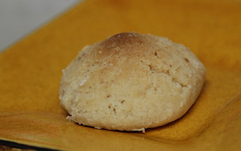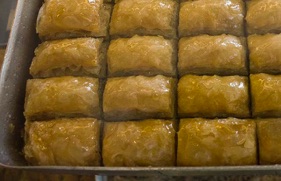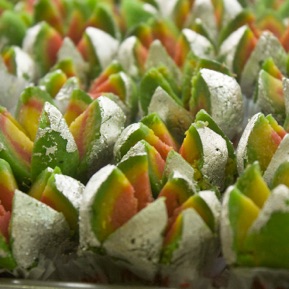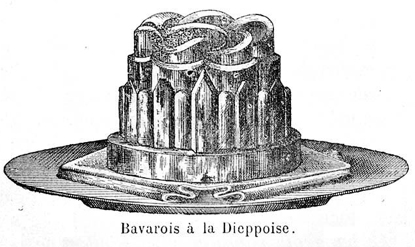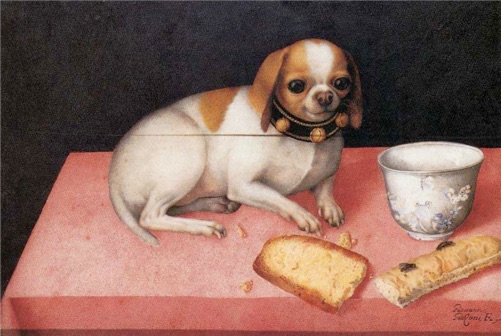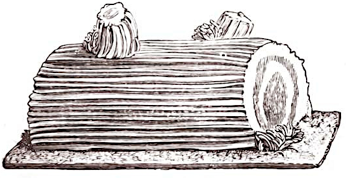A filled cookie sandwich popular in Peru and Argentina. The recipe varies according to the location. In Peru, it is like a super soft sablé or shortbread cookie with a dulce de leche filling (Traditional version). The sablé can be chocolate instead of vanilla and the filling can be honey or specifically algarrobo honey (from Prosopis pallida, a desert tree), or dulce de leche mixed with a fruit purée (popular flavors include lúcuma [Pouteria lucuma], cherimoya or guanabana (soursop). The Argentinian version is dipped in chocolate; the cookies are not as soft. Thanks to Aracelli Zea.
A candy molded into lozenges or more fanciful shapes. From the Portuguese
alfeloa.
A sweet, wheatberry pudding made with dried fruits.
asure
A sort of soufflé or baked pudding lightened by the addition of whipped egg whites. An
auflauf can be either sweet and savory.
Auflauf
In the eighteenth century, French cooks adapted the central European
Kugelhupf under the Polish name “baba.” The popularization of the dessert (and even occasionally its invention) in France is widely ascribed to the exiled Polish king Stanislaw Leszczynski and/or his cook Nicolas Stohrer. Early versions of the recipe yielded a buttery, yeast-leavened cake flavored with saffron and cooked in a ring pan. Sometime in the early nineteenth century cooks began soaking the cooked cake in rum syrup, the version familiar today in both France and Italy.
A
brittle, small, round cookie often containing sesame, almonds and spices.
baklava Southeastern Europe & Middle East
Baklava is made by layering sheets of
yufka (
filo) with butter. This is then baked and soaked with sugar syrup (Greeks often add some honey). In the version mostly commonly sold in pastry shops there is a middle layer of nuts sandwiched between some 10-20 sheets of filo on top and bottom. Rustic versions contain no nuts, while others have a cream filling and very early Ottoman recipes even include sweetened lentils in
the filling. While the idea of layering thin layers of dough may date back to medieval Arab civilizations or possibly even Ancient Rome, baklava as we know was probably developed in or around Istanbul/Constantinople soon after the Ottoman conquest.
barfi (also burfi) South Asia
This is made by cooking down milk along with sugar to a fudge-like consistency. The mixture can be colored, flavored with nuts, legumes, fresh or dried
fruit, spices and even carrots. Sometimes the milk is omitted resulting in a texture closer to marzipan. You’ll see it cut into squares like American fudge, formed into balls, layered or rolled into multicolored slices and decorated with ground nuts, dried milk, coconut or silver foil.
burfi
Literally, “softshell tortoise” this dish is made from Chinese yam, flour and sugar. It is steamed and shaped to look like a tortoise.
Bavarian cream US, UK, bavarois France
coming soon
Brazo gitano Spain, South America
Bread pudding US, UK, Spain, Portugal, France, and others
This chocolate candy is made by making a sort to fudge with condensed milk, butter and cocoa powder and rolling this into balls. The sweet (meaning “Brigadier”) is also known in some southern Brazilian states as
negrinho (literally "blackie"). It is supposedly named after Brigadier Eduardo Gomes.
A sponge roll cake shaped in the form of a yule log and frosted with buttercream traditional to France for Christmas. The dessert comes out of a seasonal French ritual in which a large log is set into the fireplace for the holiday. The cake seems to have been invented in the later part of the nineteenth century. The recipe appears in print for the first time in the 1890s. Initially it used to be made with a moka buttercream however contemporary cakes are often iced with a chocolate frosting among many other variations.
buche de noel
bûche de noël in Pierre Lacam’s, Le mémorial historique et géographique de la pâtisserie (1898)
buttercream US, UK, crème au beurre France, Buttercreme Austria, Germany
Buttercream is a rich, butter-based cake frosting or filling. The first buttercream appears to have been created in France as an ingredient for the
gâteau moka in the middle years of the 19th century. It was soon adapted by the pastry cooks of Vienna’s empire where it became ubiquitous in Austria’s numberless tortes. There are at least a half dozen ways of making buttercream most of which include egg yolks or egg whites. The so-called Italian buttercream begins by drizzling hot syrup into beaten egg whites while French buttercream uses yolks. Swiss buttercream heats the sugar with the whites. Some Central European recipes call for uncooked egg yolks or a custard base while Americans most commonly use no eggs whatsoever--using just butter and powdered sugar--making for a sweeter, denser version of the recipe.
Small tarts filled with a sugar and (typically) corn syrup filling. Other than the size, these are very similar to American syrup and chess pies.



















